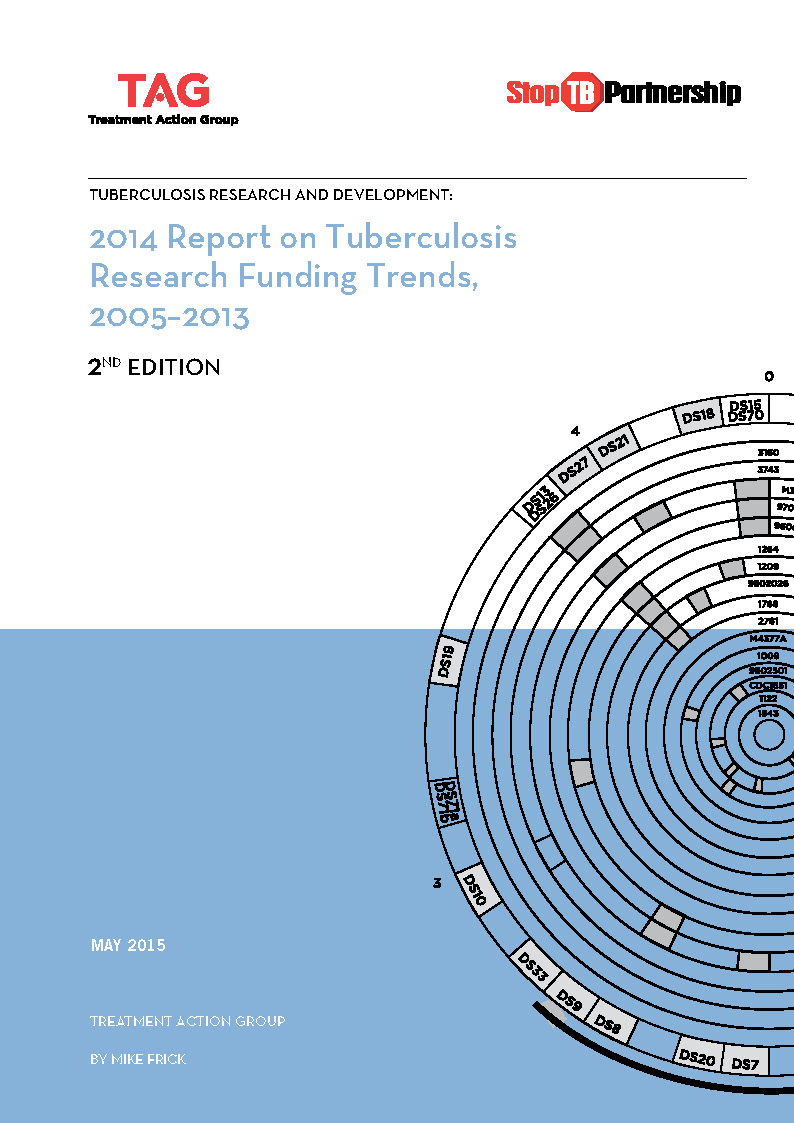2014 Report on Tuberculosis Research Funding Trends, 2005–2013. 2nd Edition
May 18, 2015
By Mike Frick
Edited by Mark Harrington and Andrea Benzacar
From the Executive Summary
Reader beware: funding data presented in this report may be less encouraging than they appear. A quick glance at Treatment Action Group’s ninth annual Report on Tuberculosis Research Funding Trends would suggest good news: funding for tuberculosis research and development (TB R&D) increased by US$37.9 million over 2012 to reach a total of $676.7 million in 2013. The foundation of the TB research enterprise, however, is shakier than at any other time since Treatment Action Group (TAG) began tracking funding levels in 2005. With an increase of $37.9 million, reported TB R&D funding has bounced back to the level observed in 2011, the year before TAG reported the first-ever decline in TB research spending in 2012. Yet this return to 2011 levels is driven by increased spending by a single philanthropic donor—the Bill & Melinda Gates Foundation (Gates Foundation)—as well as a sizeable increase in the number of funding institutions reporting to TAG.
If one looks at the data closely, the structural weaknesses of the TB R&D field become apparent. In the private sector, pharmaceutical companies are running for the exits, disbanding TB research programs as part of an industrywide pivot away from anti-infectives research toward efforts to develop new biologicals, including vaccines, and drugs for chronic illnesses. Each year brings news of another major pharmaceutical company leaving TB R&D. Following Pfizer’s exit in 2012, AstraZeneca and Novartis announced the closures of their TB drug discovery programs in 2013 and 2014, respectively. As a result, TB R&D spending from private-sector companies dropped 11.8% from 2012–2013. Since 2011, private-sector contributions to TB R&D have fallen by one-third. Combined, the private sector now spends less than $100 million on TB R&D annually. Total spending of just $99.6 million by this sector in 2013 falls below the $99.9 million industry spent on TB research in 2009 at the peak of the economic crisis. Political leaders may have declared the worst of the decade’s opening economic malaise over, but TB research has not left the recession behind.
As more and more private-sector companies pull out of TB R&D, the onus of responsibility falls increasingly on public institutions and country governments. Public institutions contributed 60 percent of total TB R&D spending in 2013, or just under $400 million. Sixty-two percent of public spending comes from a single country—the United States—where perennial budgetary battles in the U.S. Congress create uncertainty and, in some instances, capricious cuts to longstanding research endeavors. Federally mandated, acrossthe- board budget cuts under sequestration in 2013 led to lower TB R&D spending by the U.S. National Institute of Allergy and Infectious Diseases (NIAID) and the U.S. Centers for Disease Control and Prevention (CDC)—the first- and ninth-largest funders of TB R&D globally.
Significant funding shortfalls persist in every category of TB research tracked by TAG. In the 2011–2015 Global Plan to Stop TB (2011–2015 Global Plan), the Stop TB Partnership laid out a roadmap for TB research across five areas—basic science, diagnostics, drugs, vaccines, and operational research—and estimated required spending for each. Now at the midpoint of the period covered by the 2011–2015 Global Plan, it is apparent that the world is far off track for meeting the minimum financial conditions for success. Of the $9.8 billion in funding called for between 2011 and 2015, the world invested just $1.99 billion by the end of 2013.
An editorial opening the 2011–2015 Global Plan called for a “quantum leap in TB research.” The exponential increase in TB research envisioned by the authors of the 2011–2015 Global Plan has not materialized. While we have progressed far slower than the speed of light, the word “quantum” still holds relevance for our current moment. The Latin root of quantum means “how much?” With the next iteration of the Global Plan already under development, one of the most pressing questions remains: how much money will be required to develop and roll out the new diagnostics, drugs, and vaccines needed to achieve “a world free of TB” by 2035, a vision endorsed by the 67th World Health Assembly in May 2014.
For the 8.6 million people who developed active TB disease in 2012, the question becomes: “How long?” The world waited over 40 years between the introduction of rifampicin and the approval of the next new drug from a new class of drugs (bedaquiline) in December 2012. Over 120 years elapsed between the advent of smear microscopy and the introduction of GeneXpert for the diagnosis of TB. And the world is still waiting for a vaccine that can replace or improve the bacille Calmette-Guérin (BCG) vaccine introduced in 1921. TB-affected communities and patients cannot afford to wait several decades more to see the next generation of tools to fight TB.

